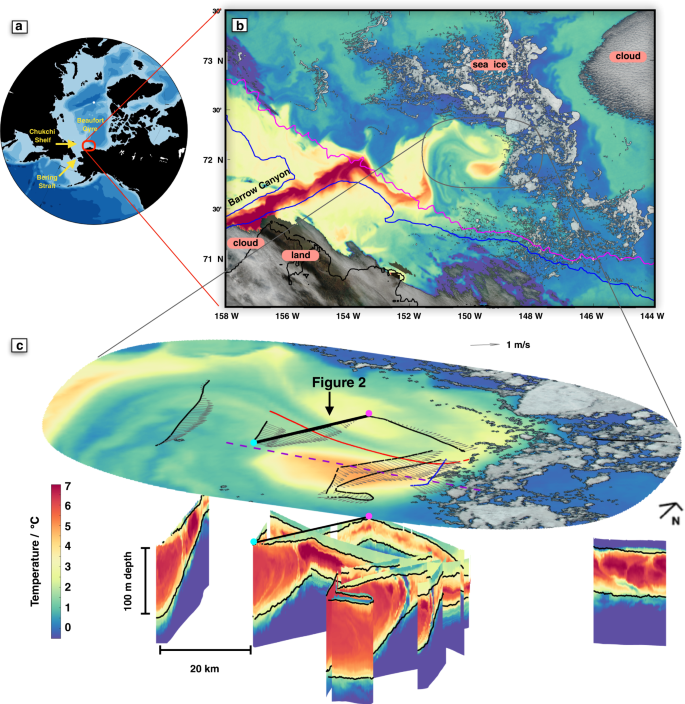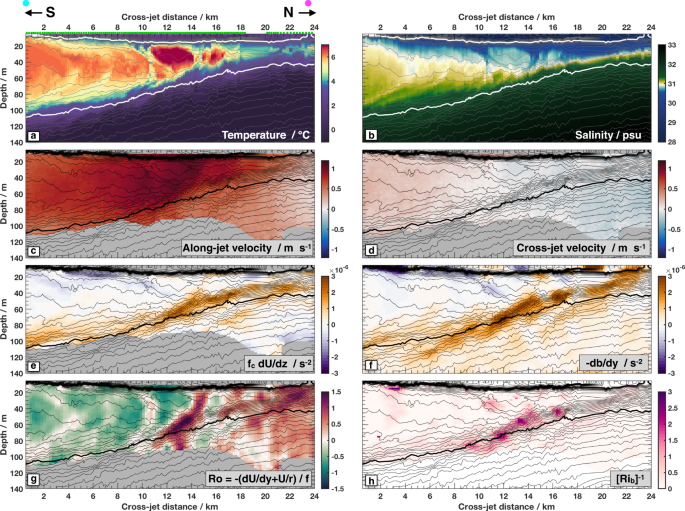The 'Heat Bombs' Destroying Arctic Sea Icehttps://phys.org/news/2021-04-arctic-sea-ice.html
A team led by physical oceanographers at Scripps Institution of Oceanography at the University of California San Diego, and including Bangor University scientist, shows in a new study how plumes of warm water are flowing into the Arctic Ocean from the Pacific Ocean and accelerating sea ice melt from below.
The research primarily funded by the Office of Naval Research describes so-called underwater "heat bombs" as one of many mechanisms by which global warming-driven encroachment is changing the nature of the Arctic Ocean faster than nearly any other place on Earth. It adds to a growing body of evidence that suggests that Arctic sea ice, a source of global climate stability, could disappear for larger portions of the year.
"The rate of accelerating sea ice melt in the Arctic has been hard to predict accurately, in part because of all of the complex local feedbacks between ice, ocean and atmosphere; this work showcases the large role in warming that ocean water plays as part of those feedbacks," said Jennifer MacKinnon, a physical oceanographer at Scripps, chief scientist of the expedition, and lead author of the paper.
The study appears in the journal
Nature Communications.Because this water is saltier than the Arctic surface water, it is dense enough to "subduct," or dive beneath, the fresh Arctic surface layer. Its movement creates pockets of very warm water that lurk below surface waters. Scientists have been seeing these pockets of warm sub-surface water strengthen over the last decade.
These pockets known as "heat bombs'' are just stable enough to be able to last for months or years, swirling far north beneath the main ice pack near the north pole, and destabilizing that ice as the heat in them gradually but steadily diffuses upwards to melt the ice. Until now, though, the process by which the warm water subducts has neither been observed nor understood. Without that understanding, climate scientists have been unable to include this important effect in forecast models, some of which under-predict accelerating sea ice melt rates. Given that the influx of warm Pacific origin water has been growing over the past decade or so, this work adds to a growing body of evidence that Arctic sea ice, a source of global climate stability, could disappear for large portions of the year.
In a 2018 expedition funded by the US Office of Naval Research, scientists for the first time caught one of these dramatic subduction events in the act. The group used a combination of novel oceanographic instruments developed by the Multiscale Ocean Dynamics group at Scripps, satellite observations analyzed by colleagues at the University of Miami, profiling float data from the National Oceanic and Atmospheric Administration, biological samples collected by British and German colleagues working in a project known as Changing Arctic Ocean, and detailed data analysis by colleagues at several other institutions. ...

Jennifer A. MacKinnon et al.
A warm jet in a cold ocean,
Nature Communications (2021)
https://www.nature.com/articles/s41467-021-22505-5Abstract:
Unprecedented quantities of heat are entering the Pacific sector of the Arctic Ocean through Bering Strait, particularly during summer months. Though some heat is lost to the atmosphere during autumn cooling, a significant fraction of the incoming warm, salty water subducts (dives beneath) below a cooler fresher layer of near-surface water, subsequently extending hundreds of kilometers into the Beaufort Gyre. Upward turbulent mixing of these sub-surface pockets of heat is likely accelerating sea ice melt in the region. Crucially, the processes seen here occur at small horizontal scales not resolved by regional forecast models or climate simulations; new parameterizations must be developed that accurately represent the physics.
...The growing heat content of the PSW sub-surface layer has a first-order effect on accelerating sea ice melt rates in this region, in several ways6,15,19. In the short term, the fate of subducted heat may impact the timing of sea ice growth in late autumn, if it remains close enough to the surface to be rapidly mixed upwards by strong fall storms20. Longer-term and basin-wide, the observed rate of Arctic sea ice decline thermodynamically requires only a 1 W m−2 imbalance in heat exchange between ocean and atmosphere7. Annually averaged, heat flux rates through Barrow Canyon were 3 TW in 201021, a value that has likely grown in the last decade8. If all the heat entering through Barrow Canyon subducted and spread out evenly sub-surface within the BG, that would lead to a warming rate for that layer of 3 W m−2 15. Observations show that the heat content of the sub-surface PSW within the BG has nearly doubled over the last 30 years15. If all this heat were turbulently mixed upwards, it could melt more than a meter of sea ice15.
